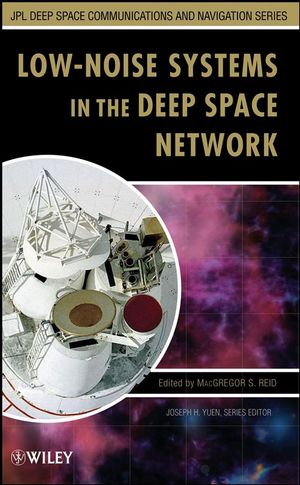Low-Noise Systems in the Deep Space NetworkISBN: 978-0-470-40228-3
Hardcover
424 pages
September 2008
 |
||||||
Preface.
Acknowledgments.
Contributors.
Chapter 1: Introduction (Macgregor S. Reid).
References.
Chapter 2: System Noise Concepts with DSN Applications (Charles T. Stelzried, Arthur J. Freiley, and Macgregor S. Reid).
2.1 Introduction.
2.2 Noise Temperature Concepts.
2.3 Antennas.
2.4 Low-Noise Amplifiers.
2.5 Receiving Systems.
2.6 Measurements.
2.7 Radiometers in the DSN.
2.8 Status and Future.
Notation and Terms.
References.
Chapter 3: Ruby Masers (Robert C. Clauss and James S. Shell).
3.1 Introduction.
3.2 Ruby Properties.
3.3 Spin Resonance, the Applied Magnetic Field, Ruby Orientation, the Low-Temperature Requirement, and Excitation.
3.4 Spin-Lattice Relaxation Time, Inversion Ratios, Transition Probabilities, the Filling Factor, and Magnetic.
3.5 Ruby Maser Noise Temperatures.
3.6 Ruby Masers as Noise Temperature Standards.
3.7 Immunity from Radio Frequency Interference (RFI).
3.8 Early DSN Cavity Masers.
3.9 Comb-Type Traveling-Wave Masers.
3.10 Reflected-Wave Masers.
3.11 Ka-Band and the Return to Cavity.
3.12 Analysis of Maser Designs.
References.
Chapter 4: Cryogenic Refrigeration Systems (Robert C. Clauss).
4.1 Introduction.
4.2 Advantages of Using Cryogenic Cooling.
4.3 Open-Cycle Refrigeration.
4.4 Heat Transfer.
4.5 Antenna-Mounted Operation.
4.6 Closed-Cycle Helium Refrigerators.
4.7 Conclusion.
References.
Chapter 5: HEMT Low-Noise Amplifiers (J. Javier Bautista).
5.1 Introduction-Semiconductor Conductivity.
5.2 The Many Acronym-ed Device (MAD)--A Brief HEMT History.
5.3 HEMT Growth Technology.
5.4 HEMT Materials Evolution--From GaAs to InAs.
5.5 Device Fabrication.
5.6 HEMT Noise Modeling.
5.7 LNA Development.
5.8 LNA Modeling and Characterization.
5.9 Subsystem Measurements.
5.10 Conclusion.
References.
Chapter 6: Atmosphere Attenuation and Noise Temperature at Microwave Frequencies (Shervin Shambayati).
6.1 Introduction.
6.2 Surface Weather.
6.3 Water Vapor Radiometer Data.
6.4 Weather Forecasting.
6.5 Concluding Remarks/Future Directions.
References.
Chapter 7: Antenna Calibration (David J. Rochblatt).
7.1 Introduction.
7.2 Calibration System Requirements.
7.3 Conventional Approach to Aperture Efficiency and Pointing Measurements.
7.4 The Raster-Scan Method.
7.5 Blind-Pointing Calibration.
7.6 Cassini-Jupiter Microwave Observation Campaign (Cassini JMOC).
7.7 Operational Antenna Calibration & Measurement Equipment (ACME) for the DSN.
7.8 Conclusions.
References.
Chapter 8: Microwave Antenna Holography (David J. Rochblatt).
8.1 Introduction.
8.2 Holography System Simulation.
8.3 Holography Receiver Signal Analysis.
8.4 Mathematical Formulation Data Processing.
8.5 Applications.
8.6 Conclusion.
References.
Acronyms And Abbreviations.



